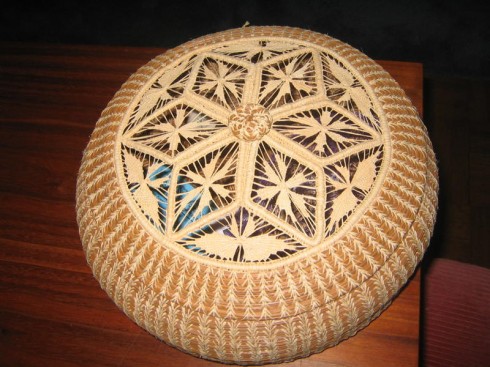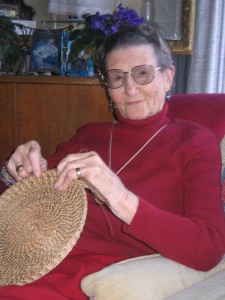It was “love at first stitch” says Florence Powers of her introduction to pine needle basketry 30 years ago. After gaining a great deal of manual dexterity in her career as an RN in the San Francisco VA Hospital’s Operating Room and elsewhere, followed by a decade of “tatting” after her 1970 retirement, the move to basketry came easily. Flo was intrigued by the materials she continues to use today: the dry honey-colored pine needles, collected primarily from Georgia, Florida & California, and store-bought raffia, from palm fronds whose origins were in Madagascar.

Following an afternoon’s lesson from her sister in 1980, Flo taught herself the craft from how-to books and magazines found in flea markets. Early on she came across the excellent paperback books of Jeannie McFarland, which provided historical background on pine needle basketry in the U.S., as well as instruction in the seminal stitches used (e.g., the back, fern, popcorn & wheat stitches), and the application of teneriffe designs. Ms. McFarland believed that it was the Gullah African-Americans, brought here as slaves from West Africa, that first used pine needles in the U.S. when creating their South Carolinan baskets of sweet grass and palmetto fronds. However, the craft in its current form didn’t take shape until the late 1950s through the 1970s when Ms. McFarland and other craftswomen developed their own designs & popularized them through publications and classes. Flo adapted the book designs of these women to her own style of basketry, and began receiving awards for her intricate work only a year after she took up basketry.
Since then, she has developed her own reliable techniques for the coiling and stitching of the pine needles. While others soak their needles in glycerin or boil them prior to use, Flo soaks hers in water, wraps a fist-size bunch in paper towels, and leaves it in her freezer. Thus, she says, she can begin a new basket whenever she has the urge. However, once the form is initially set with these damp needles, Flo will continue her basket with dry needles. The natural raffia she uses is carefully divided into thin even strands with a needle before stitching. She will characteristically start her pine needle coiling with a back stitch but will quickly move into the more elaborate variations on the wheat stitch or fern stitch so that a finished basket may have a number of patterns swirling in different directions. Her basket covers, often with teneriffe designs, are tightly fitted with mathematical precision. Flo’s favorite needles are from the longleaf pines of the East Coast of the U.S. because of their rich golden hue, but she also uses Canary Island pine needles from trees growing near her Daly City, California home, as well as those of native California pines from the Sierra Mountains.
In fact, since Flo has been a world traveler ever since her trips in the 1950s as an RN on the American and Presidential Cruise lines, she has made it a point to collect pine needles in whatever country she visits, and has made her own souvenir baskets from Korean, Japanese, Greek, Israeli, and Italian needles. Traveling with her kit of raffia, thimble, scissor, & darning needle, Flo easily became a center of attraction on her cruise ship journeys as she demonstrated her craft, making new friends in the process. By the time she completed her round-the-world travels with her husband, Ray, this “ little ole farm gal” (Flo’s words!) born in a Minnesota farmhouse and raised in South Dakota, had accomplished more than she had ever could have imagined as a child.
Once Flo has created her basic form, she may add teneriffe embroidery on wire frames to create amazingly complicated and delicate patterns. Her works of love are time-consuming; the smallest basket may take a minimum of eight hours while larger, award-winning baskets with teneriffe may take 200 hours or more. She finishes her baskets by applying shellac cut half and half with denatured alcohol.
 While Flo’s love for her pine needle craft is evident in the perfection and rigor of her baskets, her approach to it is relaxed. Flo says that her craft “satisfies her urge to create”, but jovially adds she “can’t just sit and watch TV.” Sometimes she may start a basket, but then put it aside for months until the inspiration to begin again grabs her. But basketmaking has also been a comfort to Flo. In Ray’s last years, when he was debilitated by Alzheimer’s and Flo was his sole caregiver, she explained that “the escape and leisure I felt when working on a project is better than an entire bottle of Prozac.”
While Flo’s love for her pine needle craft is evident in the perfection and rigor of her baskets, her approach to it is relaxed. Flo says that her craft “satisfies her urge to create”, but jovially adds she “can’t just sit and watch TV.” Sometimes she may start a basket, but then put it aside for months until the inspiration to begin again grabs her. But basketmaking has also been a comfort to Flo. In Ray’s last years, when he was debilitated by Alzheimer’s and Flo was his sole caregiver, she explained that “the escape and leisure I felt when working on a project is better than an entire bottle of Prozac.”
Florence gets a real kick out of the awards she reliably and annually receives at her local San Mateo County Fair (“First Place”, “Best of Division, “Best of Show”) and has exhibited and sold her baskets at shops and galleries in California. She joined the Bay Area Basketmaker’s (BABM) as soon as she learned about it in 1998, and was immediately recruited to teach a class for BABM members; two years later a basket entered into CNCH competition won an Award for Excellence. But the award that tickles Flo the most is a 2002 Guinness World Record for the “world’s smallest woven basket”; her nephews insisted that she submit a basket she had made with short pine needles Flo’s sister had brought her from Israel. The finished lidded basket was .3 inches in diameter—smaller than a dime – and made from only 12 pine needles.
Today Flo is an “honorary member” of BABM, and although no longer driving, enthusiastically attends meetings whenever she can get a ride. Her home is a gallery of her basketry skill with some 30 or more pine needle baskets exhibited – often with their award ribbons still attached; her garage contains scores of carefully wrapped pine needle bundles for future use with the date and place of collection noted. Apart from her artistry, what is most significant about Flo’s craft is her willingness to share her knowledge and expertise with the rest of us – to inspire us to learn & replicate her craft.
To read about another treasured guild member, click here.